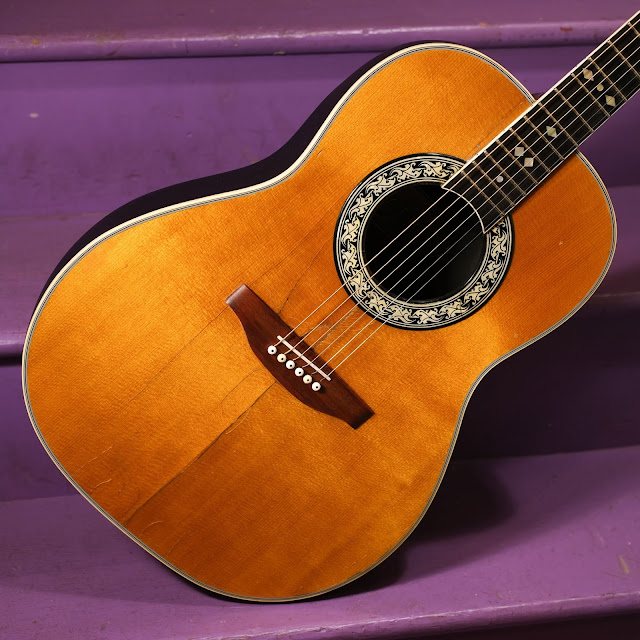1969 Ovation 1127-4 Glen Campbell Balladeer 000-Size Guitar
This Glen Campbell Artist-model Balladeer is a curious one and has serial number 8492 at the neckblock and a "foil" label. The foil suggests '70s but the serial number dates it right around 1969-70.
If you've ready the blog for a while, you might know I'm a secret fan of Ovations. One of my favorite guitars in the past was an old first-year-of-production Balladeer with the "shiny bowl." I think the early ones sound especially good and all of them sound far better without the electronics installed (early piezo pickups in the saddle slot might as well be acoustic damps for all the "tone" they supply).
They've got good features -- strong, fast-playing, multi-ply necks with functional truss rods, durability provided by the synthetic back, and good sound via the solid spruce top. Some early ones were x-braced but the vast majority have weird bracing. Some have tonebars and some (like this one) have a half-ladder/half-fan hybrid pattern. This one sounds a lot like an x-braced guitar but it has a bit more drive and snap in the mids. It's a good voice to match the round back.
I will say, though, that I think the company started going downhill by the time the thin-depth bowls, fancy electronics, and import models arrived in their lineup. The best stuff seems to be pre-late-'70s and all of it generally needs a good amount of love by this time.
This one arrived with a pinched neck joint, a bridge held on with 3 drywall screws (set into a big piece of ply set under the braces behind the top -- kinda great and kinda horrible, hee hee), and fairly-dramatic damage around the bridge (broken-up pieces of top and various cracks). Post-work, though, it plays beautifully and has a great voice.
Repairs included: reinforcement bracing for the upper bout, a new custom bridge (w/pin load, to replace the broken original), bone saddle, bridge plate additions (in spruce), a fret level/dress, crack repairs/cleats, and setup.
Setup notes: it plays low and fast with 3/32" EA and 1/16" DGBE action at the 12th fret, strung with 54w-12 gauges, and with a functioning truss rod and straight neck.
Scale length: 25 1/4"
Nut width: 1 11/16"
String spacing at nut: 1 3/8"
String spacing at bridge: 2 1/16"
Body length: 20 1/4"
Lower bout width: 15 1/2"
Waist width: 10"
Upper bout width: 11"
Side depth at endpin: 5 1/4"
Side depth at endpin: 5 1/4"
Top wood: solid spruce
Back/sides wood: synthetic
Bracing type: fan/ladder hybrid
Fretboard: ebony
Bridge: replacement rosewood-like, original was walnut?
Neck feel: slim C, ~10" board radius
Condition notes: while the neck joint is pinched and there are a number of repaired top cracks, the guitar is now in good shape and all-original save bridge, saddle, and bridge pins.
Below are a couple shots of how the bridge looked before:
















Comments